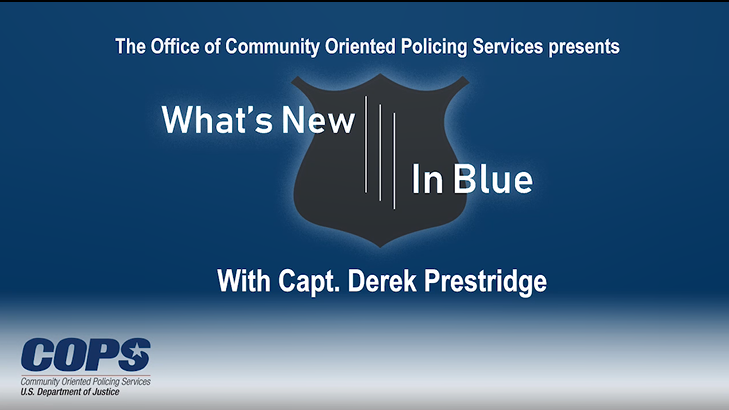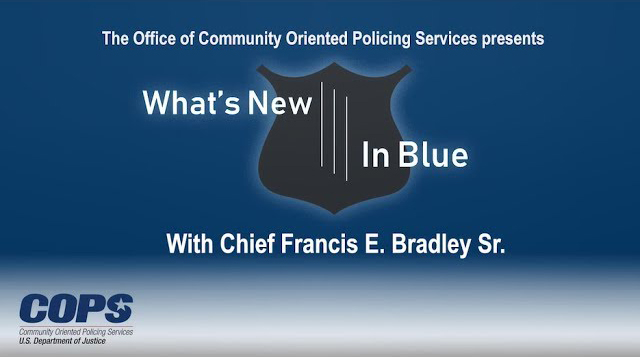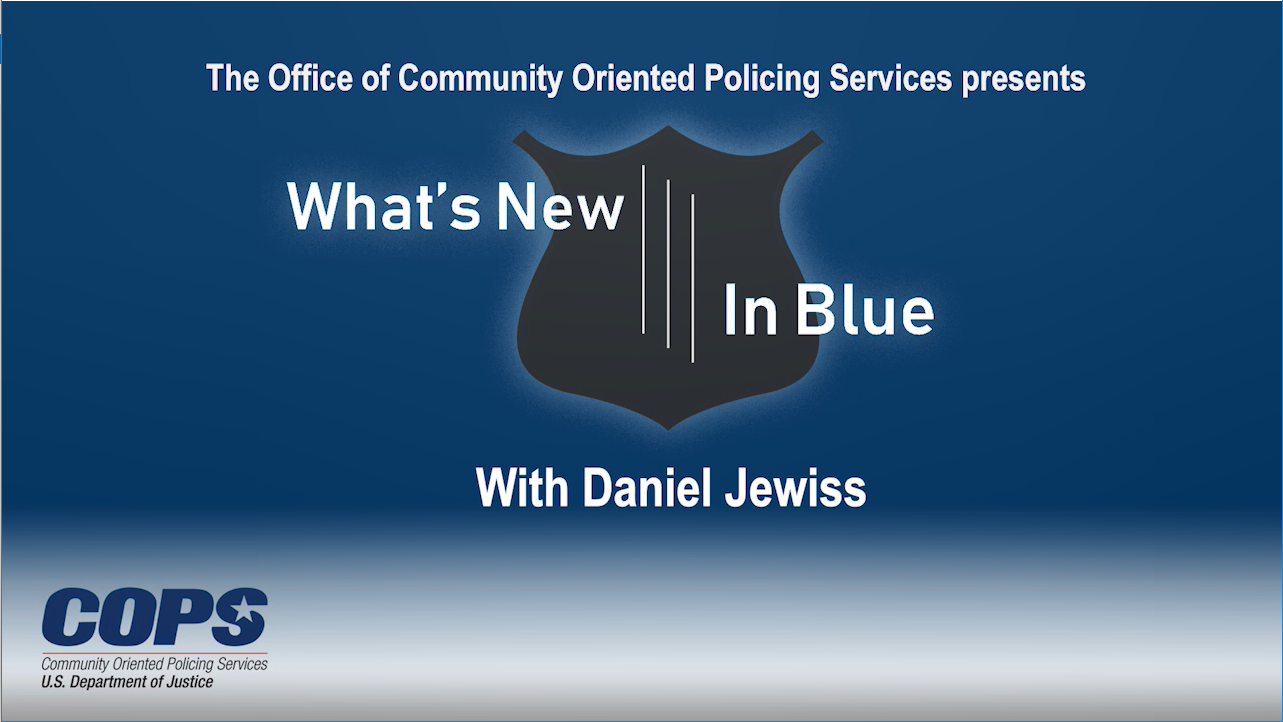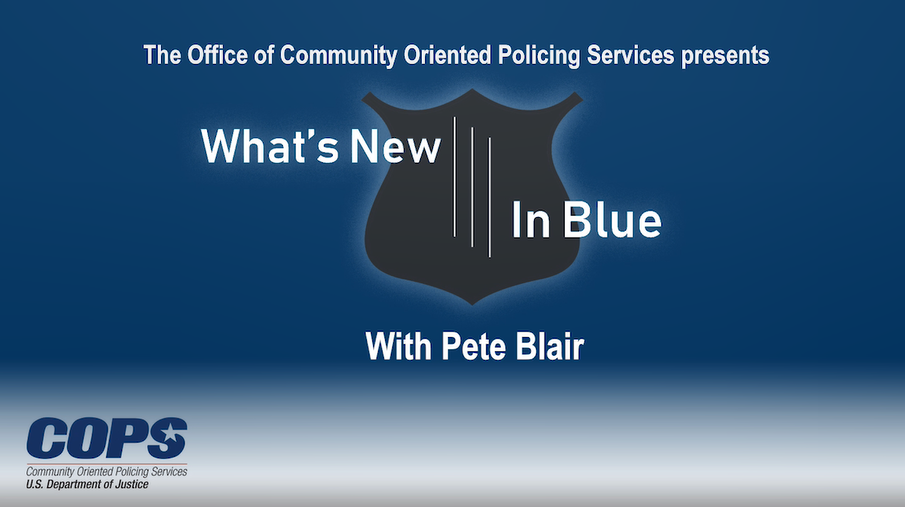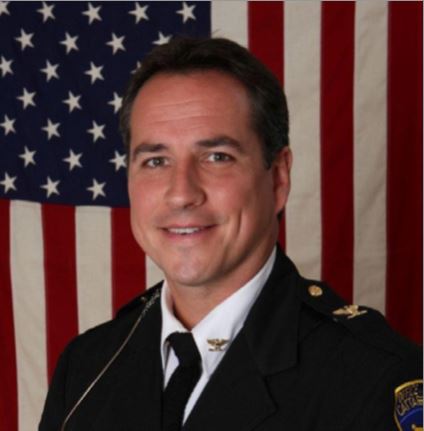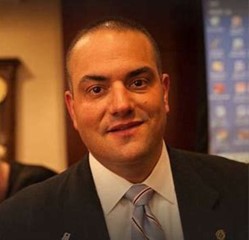Inspired by the approach used for TED Talks, What’s New in Blue is a series of short videos intended to keep viewers informed about innovative developments and critical issues in law enforcement. The episodes feature informative discussions about ideas worth spreading throughout American policing in a format useful for viewing in roll call, training classes, or sharing with colleagues and across social media.

FEATURED EPISODE
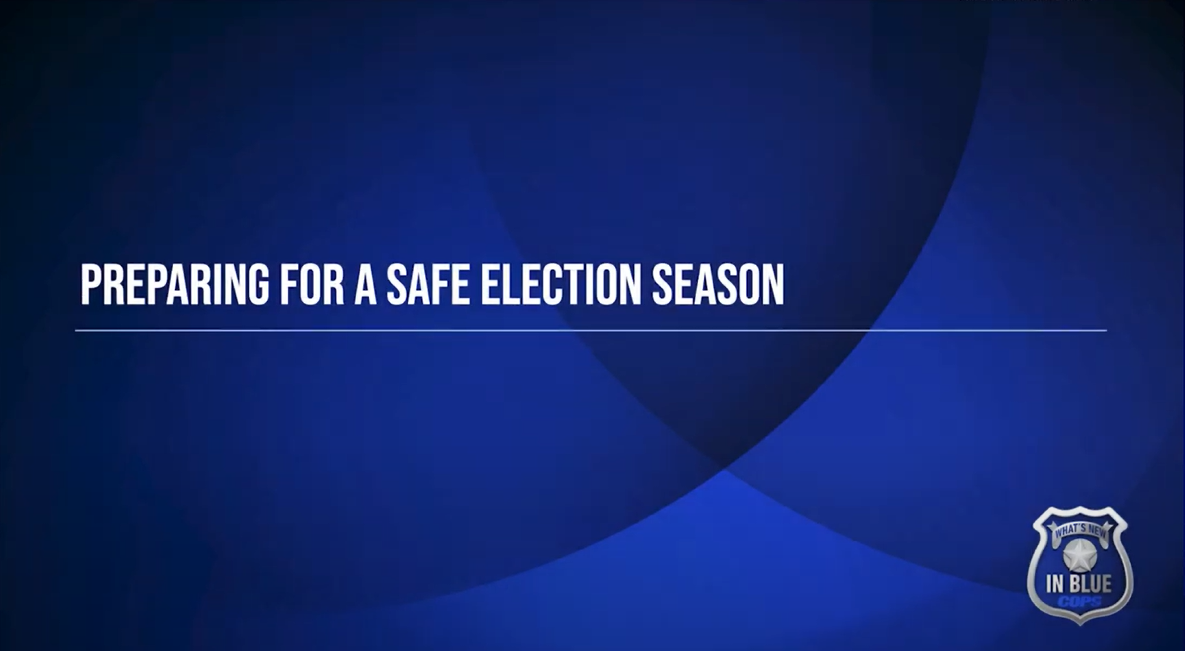
Season 4 Episode 1 | Preparing for a Safe Election Season
During election season, law enforcement has a vital mission: to keep election officials, voters, and the public safe and ensure a welcoming environment for all voters. The ideal approach to this mission will look different in every jurisdiction across the country: local law, community expectations, historical experience, and the ongoing threat environment all shape how different departments meet the moment. In some jurisdictions, statutes limit what roles law enforcement can play at polling sites. In others, law enforcement is expected to be at key election locations. Yet, there are some key takeaways that will be helpful to every department in planning for a safe and secure election season.
In this episode of What’s New in Blue, hear from Sheriff (Ret.) Paul Penzone of the Maricopa County (Arizona) Sheriff’s Office and Chief Chris Davis of the Green Bay (Wisconsin) Police Department as they discuss lessons they have learned about preparing for a safe election season, particularly when faced with intelligence or evidence of threats to voters, election officials, or polling places. Advanced planning, an understanding of applicable laws, and thoughtful collaboration with community partners are crucial.
Season 1 | Episode 1: What’s New in Blue feat. Dr. Jon Sheinberg
This episode of What’s New in Blue features Dr. Jon Sheinberg, a Board Certified Cardiologist and sworn officer from Texas who discusses the prevalence of coronary disease in law enforcement and offers suggested measures for officers to prevent heart attacks.
Season 1 | Episode 2: What's New In Blue: Interdiction for the Protection of Children feat. Capt. Derek Prestridge
The Texas Department of Public Safety established the Interdiction for the Protection of Children (IPC) Program in 2007. The program trains local law enforcement officers to identify and question suspects, during regular patrol stops, who may be trafficking children or involved in child abductions. In 2014, the COPS Office awarded the Texas Department of Public Safety a Microgrant to implement a nationwide train-the-trainer program and it has received numerous accolades from federal, state, and local law enforcement agencies across the country. In this episode, Captain Prestridge speaks about the Interdiction for the Protection of Children project focusing on how the project began, its expansion across the country, and outcomes of the project.
Season 1 | Episode 3: What's New In Blue: Coffee with a Cop feat. Sgt. Chris Cognac
In this episode of What's New in Blue, Sergeant Chris Cognac of the Hawthorne (CA) Police Department (HPD) discusses "Coffee with a Cop" - a nationwide initiative that provides officers and community members with a unique opportunity to connect over coffee. Sergeant Cognac was a part of the HPD team that created "Coffee with A Cop" in 2011, and he is the main National Instructor for the "Coffee with a Cop" training class. A true believer in the ability of individual officers making a difference in the communities they serve, he talks about how he used his networking and communication skills as a force multiplier, and how all agencies can put people who want to help the community with those in need of an opportunity.
Season 1 | Episode 4: What's New In Blue: Policing in Indian Country feat. Chief Francis Bradley Sr.
In this episode of What’s New in Blue, Chief Francis Bradley Sr. discusses the importance of culture in policing in Indian Country. Francis Bradley is the Chief of Police for the Hualapai Nation in Peach Springs, AZ. He is a graduate of the FBI National Academy Session 232 and retired as a commander with the Navajo Nation Police Department where he served from 1980 to 2002.
Season 1 | Episode 5: What's New In Blue: Dispatch Response During Active Shooter Events feat. Dan Jewiss
In this episode of What’s New in Blue, Dan Jewiss discusses the role and training needs of dispatchers as a tool to enhance the capacity of first responders during critical incidents. Dan Jewiss is a retired Trooper and Detective of the Connecticut State Police. He worked as a Trooper for four years and then spent 12 years as a Detective in the Western District Major Crime Squad where he investigated numerous felony cases, including the 2012 Sandy Hook Elementary School Shooting.
Season 1 | Episode 6: What's New In Blue: Coordinated Responses to Mass Casualty Events feat. Dr. Pete Blair
In this episode of What’s New in Blue, Dr. Blair speaks about the Advanced Law Enforcement Rapid Response Training (ALERRT) Center and the importance of coordinating responses among law enforcement, fire services and medical community to respond to active shooter/critical incidents. Dr. J. Pete Blair is a Professor of Criminal Justice and the Executive Director of the ALERRT Center at Texas State University. In FY 2017, the COPS Office made an award to the ALERRT Center at Texas State University to increase law enforcement and public safety through scenario-based training that prepares officers and other first responders to handle active-shooter and other violent threats safely and effectively.
Season 1 | Episode 7: Micro Community Policing Plans feat. Lt. Adrian Diaz
This episode of What’s New in Blue features Lieutenant Adrian Diaz, who is a key member in implementing Seattle (WA) Police Department’s Micro Community Policing Plans (MCPP). MCPP’s are designed to address the distinctive needs of each community. The plans take a three-prong approach that brings community engagement, crime data and police services together to get direct feedback on perceptions of crime and public safety. Lieutenant Diaz speaks about the development of the MCPP program, outcomes of the project, and tips for other departments looking to develop a similar program.
Season 2 | Episode 1: Officer Suicide feat. Sheriff Tim Whitcomb of Cattaraugus County, NY
We are all familiar with the truism that policing is a hard job. However, for the women and men who walk the thin blue line, that statement is more than just a simple adage. The physiological and emotional toll paid by officers in the United States is an inherent part of the job that only those who have worn the uniform can fully understand. In this episode of What’s New in Blue, Sheriff Whitcomb tells the heartfelt story of a fellow officer’s suicide that became his wake-up call and spurred his crusade to help law enforcement officers minimize and dissipate the effects of post-traumatic stress disorder (PTSD).
Season 2 | Episode 2: Stop the Bleed feat. Dr. Alex Eastman*
In colloquial terms, Alex Eastman can be described as a “unicorn.” He is a Dallas (Texas) Police Department (DPD) lieutenant, the lead medical officer for DPD special weapons and tactics (SWAT), and the Deputy Medical Director of the department. In addition, he was appointed to serve as senior medical advisor to the U.S. Department of Homeland Security, and he is a Special Deputy U.S. Marshal on the North Texas Fugitive Task Force.
In this episode of What’s New in Blue, Dr. Eastman discusses life-threatening hemorrhages, which are a huge threat to officers who have been injured in the line of duty and are a major concern to medical professionals who treat them. Using his wealth of knowledge and experience, Dr. Eastman equips the audience with information to help “Stop the Bleed,” in order to reduce the loss of life due to traumatic bleeding.
Season 2 Episode 3 | What's New in Blue: Movement Forward's OneCOP Initiative feat. Reverend Markel Hutchins
Having studied at the knee of some of our nation’s most revered civil rights leaders, Rev. Hutchins’s commitment to serving people and communities started at an early age—as did his involvement working with police and communities to reduce violence and address perceptions of injustice. More often than not, this meant working with police in a manner that might not universally be described as collaborative. Then, in 2009, following a divisive police-involved shooting, things changed. For the first time, Rev. Hutchins was forced to view police-community related issues differently, and this led to a newfound conviction for getting law enforcement and communities to work together to solve problems. It also led him to found the One Congregation-One Precinct (OneCOP) movement, in which police and community leaders work through local congregations to create understanding, reduce crime, reduce bias, and have difficult but necessary conversations.
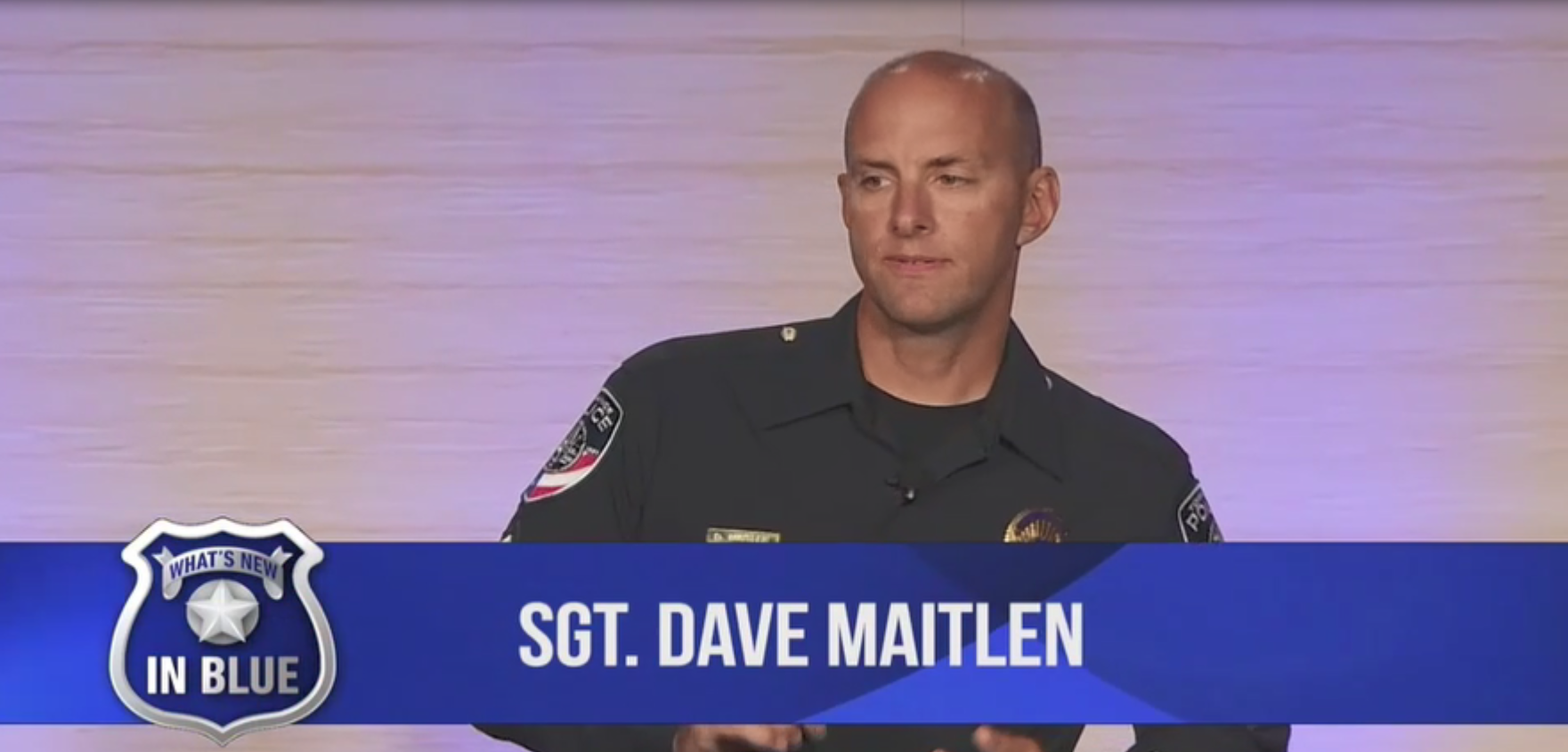
Season 2 Episode 4 | What's New in Blue: Drones feat. Sergeant Dave Maitlen
Technology systems are changing the way that American law enforcement agencies police, and one form of technology is increasingly diffusing throughout the field: drones. Throughout the country law enforcement agencies are actively trying to manage the addition of drones into their operations, address privacy concerns of the public, and navigate the regulatory requirements of the Federal Aviation Administration. The Torrance (California) Police Department is ahead of the curve in this endeavor, and they have amassed a set of experiences from which we can all learn. And, “yes”, criminals do surrender to drones. We knew you would be curious.
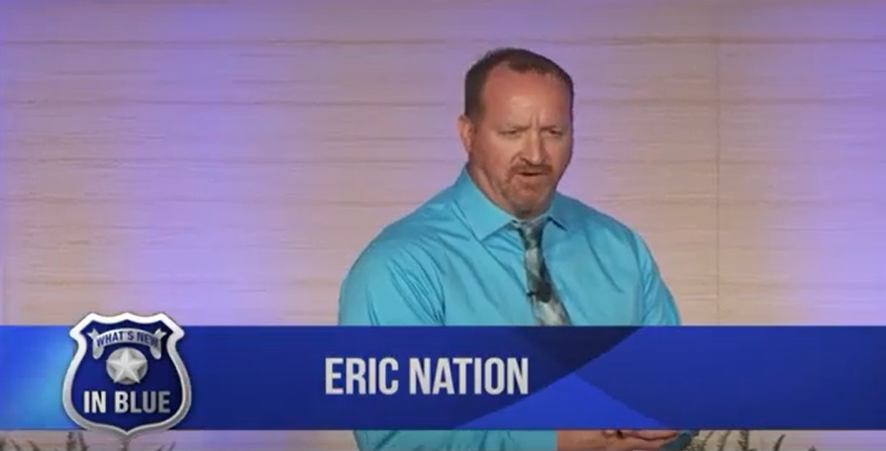
Season 2 Episode 5 | Drug Endangered Children feat. Eric Nation
Now retired, Eric Nation began his law enforcement career in 1994 and became a founding member of the Jasper County (Iowa) Drug Endangered Children Alliance. During his time in law enforcement, Nation experienced numerous cases of children who suffered physical or emotional harm as a result of drug use, possession, manufacturing, and distribution. The impact of what Nation witnessed became such a concern that he left policing to focus his efforts on training others to identify at-risk children and coordinating the various systems and disciplines that intervene and provide services to these children and families.
Eric Nation is Director of Training and Development for the National Alliance for Drug Endangered Children.
Season 3 Episode 1 | What's New in Blue: Surviving the Unthinkable: Training, Resilience, Support & Belief feat. Ranger Brody Young
Brody Young is a Utah State Parks Ranger who was shot nine times, left to die in a remote location, and is back on the job today. Ranger Young speaks candidly about the incident, his recovery, lessons the incident taught him about resilience, and how the experience has changed his life.
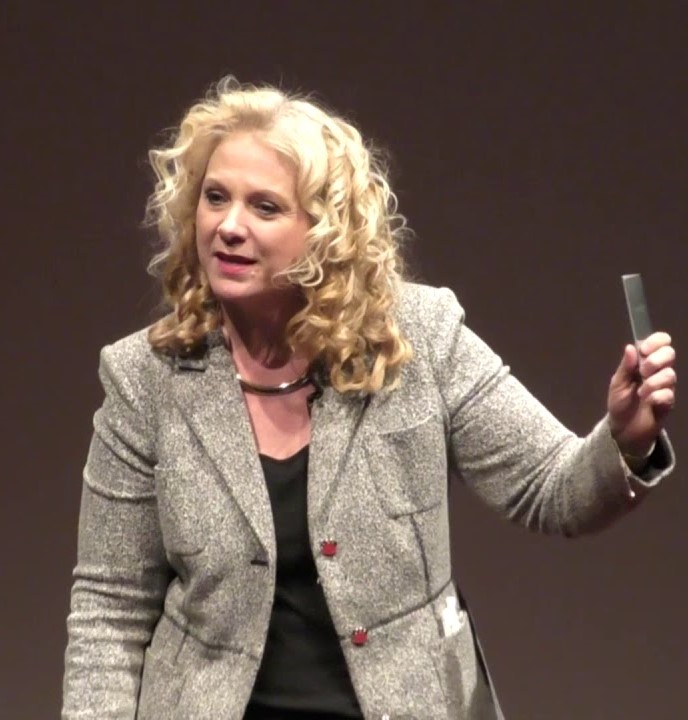
Season 3 Episode 2 | The “Lyin’ Tamer”: Interpreting Deceptive Body Language feat. Janine Driver
Janine Driver is a New York Times best-selling author and award-winning keynote speaker who spent 16 years as a Special Agent with the Bureau of Alcohol, Tobacco, Firearms and Explosives (ATF). Driver has trained over 60,000 lawyers, judges, and law enforcement officers on how to detect deception. Known professionally as the “Lyin’ Tamer,” she now shares her people-reading skills to help corporate and law enforcement professionals better understand others’ hidden emotions unintentionally expressed through body language.
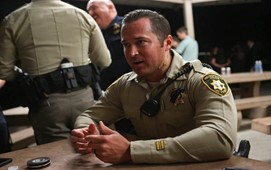
Season 3 Episode 3 | Las Vegas Route 91 Concert Mass Shooting feat. Lieutenant Branden Clarkson
Incidents of mass firearm violence galvanize public attention and challenge the capacity of first responders to initiate a coordinated response. Lieutenant Branden Clarkson was in the Las Vegas Metropolitan Police Department (LVMPD) command post during the Route 91 Concert mass shooting in 2017 and was responsible for the real-time tracking of where officers were, what they were doing, and what resources they needed. He joins What’s New In Blue to tell his story and provide insight into how the LVMPD executed a successful response.
 Official websites use.gov
Official websites use.gov Secure .gov websites use HTTPS
Secure .gov websites use HTTPS 
